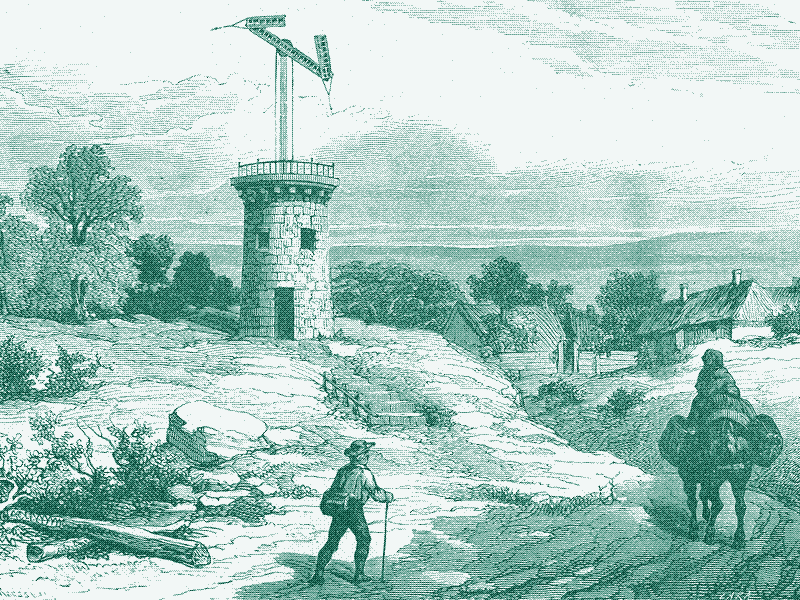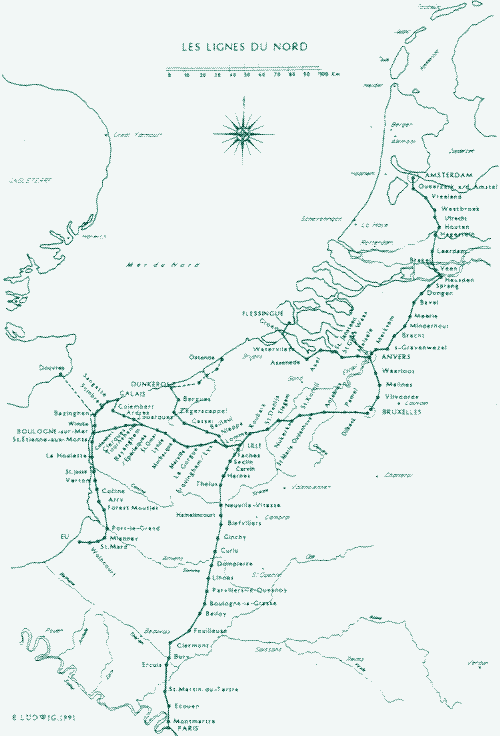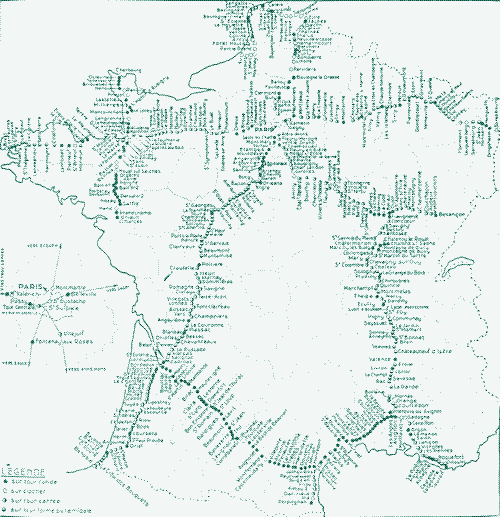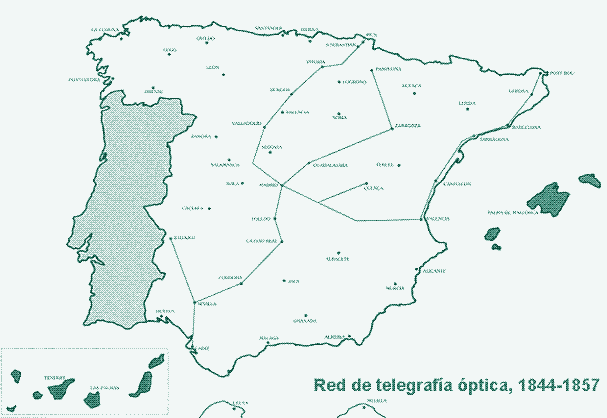
Email leaves all other communication systems far behind in terms of speed. But the principle of the technology – forwarding coded messages over long distances – is nothing new. It has its origins in the use of plumes of smoke, fire signals and drums, thousands of years before the start of our era.
Coded long distance communication also formed the basis of a remarkable but largely forgotten communications network that prepared the arrival of the internet: the optical telegraph.
Every tower had a telegrapher, looking through the telescope at the previous tower in the chain.
Throughout history, long distance communication was a matter of patience – lots of patience. Postmen have existed longer than humans can write, but the physical transport of spoken or written messages was always limited by the speed of the messenger.
Humans or horses can maintain a speed of 5 or 6 kilometres an hour for long distances. If they walk 10 hours a day, the transmission of a message from Paris to Antwerp would take about a week.
Postal services
Already in antiquity, post systems were designed that made use of the changing of postmen. In these stations, the message was transferred to another runner or rider, or the horseman could change his horse. These organised systems greatly increased the speed of the postal services.
The average speed of a galloping horse is 21 kilometres an hour, which means that the distance in time between Paris and Antwerp could be shortened to a few days. A carrier pigeon was twice as fast, but less reliable. Intercontinental communication was limited to the speed of shipping.

Centuries of slow long-distance communications came to an end with the arrival of the telegraph. Most history books start this chapter with the appearance of the electrical telegraph, midway the nineteenth century.
However, they skip an important intermediate step. Fifty years earlier (in 1791) the Frenchman Claude Chappe developed the optical telegraph. Thanks to this technology, messages could be transferred very quickly over long distances, without the need for postmen, horses, wires or electricity.
A chain of towers
The optical telegraph network consisted of a chain of towers, each placed 5 to 20 kilometres apart from each other. On each of these towers a wooden semaphore and two telescopes were mounted (the telescope was invented in 1600).
The semaphore had two signalling arms which each could be placed in seven positions. The wooden post itself could also be turned in 4 positions, so that 196 different positions were possible. Every one of these arrangements corresponded with a code for a letter, a number, a word or (a part of) a sentence.
1,380 kilometres an hour
Every tower had a telegrapher, looking through the telescope at the previous tower in the chain. If the semaphore on that tower was put into a certain position, the telegrapher copied that symbol on his own tower.
Next he used the telescope to look at the succeeding tower in the chain, to control if the next telegrapher had copied the symbol correctly. In this way, messages were signed through symbol by symbol from tower to tower. The semaphore was operated by two levers. A telegrapher could reach a speed of 1 to 3 symbols per minute.

The technology today may sound a bit absurd, but in those times the optical telegraph was a genuine revolution. In a few decades, continental networks were built both in Europe and the United States.
The first line was built between Paris and Lille during the French revolution, close to the frontline. It was 230 kilometres long and consisted of 15 semaphores. The very first message – a military victory over the Austrians – was transmitted in less than half an hour. The transmission of 1 symbol from Paris to Lille could happen in ten minutes, which comes down to a speed of 1,380 kilometres an hour. Faster than a modern passenger plane – this was invented only one and a half centuries later.
From Amsterdam to Venice
The technology expanded very fast. In less than 50 years time the French built a national infrastructure with more than 530 towers and a total length of almost 5,000 kilometres. Paris was connected to Strasbourg, Amsterdam, Toulon, Perpignan, Lyon, Turin, Milan and Venice.
At the beginning of the 19th century, it was possible to wirelessly transmit a short message from Amsterdam to Venice in one hour’s time. A few years before, a messenger on a horse would have needed at least a month’s time to do the same.

The system was copied on a large scale in other countries. Sweden developed a country-wide network, followed by parts of England and North America. A bit later also Spain, Germany and Russia constructed a large optical telegraph infrastructure.
Most of these countries devised their own variations on the optical telegraph, using shutters instead of arms for example. Sweden developed a system that was twice as fast, Spain built a telegraph that was windproof. Later the optical telegraph was also put into action in shipping and rail traffic.
A real European network never really existed. The connection between Amsterdam and Venice existed for only a short period. When Napoleon was chased out of the Netherlands, his telegraph network was dismantled. The Spanish, on the other hand, started too late.
Their nationwide network was only finished when the technology started to fall into disuse in other countries. The optical telegraph network was solely used for military and national communications, individuals did not have access to it – although it was used for transmitting winning lottery numbers and stock market data.
The optical telegraph disappeared as fast as it came. This happened with the arrival of the electrical telegraph, fifty years later. The last optical line in France was stopped in 1853, in Sweden the technology was used up to 1880. The electrical telegraph was not hindered by mist, wind, heavy rainfall or low hanging clouds, and it could also be used at night.

Moreover, the electrical telegraph was cheaper than the mechanical variant. Another advantage was that it was much harder to intercept a message – whoever knew the code of the optical telegraph, could decipher the message. The electrical telegraph also made intercontinental communication possible, which was impossible with the optical telegraph (unless you made a large detour via Asia).
The electrical telegraph was the main means of communication for transmitting text messages over long distances for more than 100 years. At first, electrical wires were used; later on radio waves were used to communicate. The first line was built in 1844, the first transatlantic connection was put into use in 1865. The telegraph made use of Morse code, where dots and dashes symbolize letters and numbers.
Not the telephone, nor the railroads, nor radio or television made the telegraph obsolete. The technology only died with the arrival of the fax and the computer networks in the second half of the 20th century. Also in rail-traffic and shipping optical telegraphy was replaced by electronic variants, but in shipping the technology is still used in emergency situations (by means of flags or lamps).
Keyboard
The electrical telegraph is the immediate predecessor of e-mail and internet. Since the thirties, it was even possible to transmit images. A variant equipped with a keyboard was also developed, so that the technology could be used by people without any knowledge of Morse code. The optical as well as the electrical telegraph are both in essence the same technology as the internet and e-mail.
All these means of communication make use of code language and intermediate stations to transmit information across large distances; the optical telegraph uses visual signs, the electrical telegraph dots and dashes, the internet ones and zeroes. Plumes of smoke and fire signals are also telegraphic systems – in combination with a telescope they would be as efficient as an optical telegraph.
Low-tech internet
Of course, e-mail is much more efficient than the optical telegraph. But that does not alter the fact that the low-tech predecessor of electronic mail more or less obtained the same result without wires or energy, while the internet consists of a cluster of cables and is devouring our energy resources at an ever faster pace.